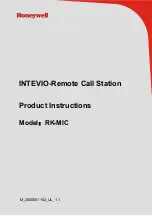
Townsend Labs Sphere L22 Precision Microphone System Guide
49
Chapter 8: Stereo Recording
The Sphere mic provides numerous options for stereo recording. Any stereo miking technique, such as XY,
spaced pair, MS, and ORTF, can be used effectively with a pair of Sphere microphones, just as you would with
conventional mics. But it’s also possible to record in stereo with a single Sphere mic. If you’re feeling
adventurous, you even can record 4- or 5-channel surround with two Sphere mics.
Single Microphone
Recording stereo with a single Sphere mic is the simplest approach, but offers less flexibility than using two
mics. A Sphere microphone can create two virtual mics with one pointing forward and the other pointing
backward. For stereo recording, the mic is rotated 90°, so the front output becomes the left channel, and the
rear output becomes the right channel. This provides a 180° (back-to-back) capsule arrangement. To use the
microphone in stereo mode, you must instantiate the Sphere 180 plug-in, which provides discrete left and right
outputs.
Because the left and right diaphragms are coincident, perfect phase coherency is always maintained, even when
the channels are summed to mono. For a coincident mic technique, this produces the widest stereo spread
possible, but will likely leave a
hole
in the center of the stereo field. This occurs because the center of the stereo
field corresponds to 90° off-axis from each capsule, which is where the high frequency response is typically
lowest. Nonetheless, if the goal is to produce a wide stereo spread with room in the middle for center-panned
material, then this is a benefit not a detriment. The best results are usually achieved by setting the polar pattern
to somewhere between cardioid and supercardioid, with supercardioid providing a wider stereo field.
NOTE:
Hypercardioid can sometimes widen the stereo field further, but it can also create phase prob-
lems, so be careful if you use that setting.
It is also possible to have independent mic models applied to the left and right outputs. For acoustic guitar
recording, pickup from the sound hole often produces an overly bassy sound, so the bridge side ends up being
too boomy and the neck side is much brighter. You can compensate for this by choosing a bridge side mic
model that is bass light, and a neck side model that is bass heavy.






































